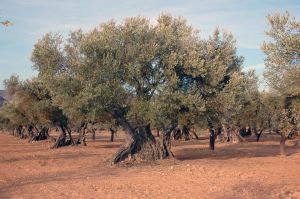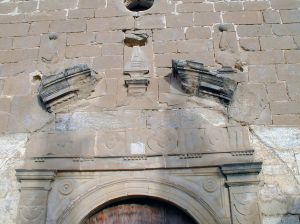Proceedings first got under way for the construction of this church in 1610 however it was to be many years before it was finished. A total of five different stone masons were employed and, due to economic difficulties, building work was continually delayed until the year 1651, when Marco Ranzón took over the project. As can be seen by the inscription on the door, the church was finally finished in 1655. Despite the length of the building work, there were few variations to the original design.
It is one of the last churches in Somontano to have been built following the late-Gothic style. In fact the complex design of the rib vaults, the decoration of the arch’s coffers or the curved pediment and appearance of the entrance doorway, already reflect the emerging style of 17th century Baroque.
The church has a nave with two sections, slightly bigger in the west end. The east end is square from the outside and polygonal on the church’s interior. Two chapels, one on each side of the nave, create a Latin cross layout.
The building is made of stone ashlars and the exterior wall of the west end shows an inscription that reads HS I MAR, alluding to the names of Jesus and the Virgin Mary.
The walls, which have small square ventilation openings to allow air to the ceiling, are crowned with brick eaves that support the roof.
From the outside it is possible to make out the chapels between the buttresses, the walls off the east end and the vestry.
The tower was built above the vestry and reflects a more contemporary style of architecture. It has two parts separated by a facia and the arched openings for the bell are at the top. One of these is now used to provide access to the vaults. Despite these apertures, the towers overall appearance is one of solidity.
The church’s main doorway is set in the wall of the west end. The semicircular arch with architrave and frieze is supported by two Doric pilasters decorated with a subtle relief of cherubs, candelabras and concentric circles. The curved pediment and moulding complete an ensemble that hints at Baroque but the centuries have taken their toll and the church façade is now in fairly poor condition.
Inside, the small nave, the east end and the chapels are covered with a stellar vault with brick recesses and a complex design.
The sections of the building are separated by well-cut stone arches whose intradoses display coffers decorated with geometric and vegetal motifs. These provide a strong link to the Baroque style. A cornice runs through the whole of the building’s interior at the height of the springers.
The chapels stand opposite one another to the sides and open up with semicircular arches supported on cantilevers that flow into a Renaissance cornice. Doors from each chapel lead to the tower and the remains of the old abbey.The choir is located in the church’s west end and the vestry is joined to the Gospel wall. This was described at the time of its creation as being “…of stone with windows and doors in keeping with the artistic style and a brick and stone vault fitting for the perfection of the work.” A trabeated doorway provides entry to the vestry and a window, also trabeated, allows light to this small space. The layout is square and runs parallel to the main axis of the church. The room is finished with a barrel vault. The church is lit from an oculus in the high part of the choir and by two semicircular windows with single stone arches in the walls of the nave.The intricacy of the ribs of the vaults, the semicircular arches and windows and the classically inspired decoration all points to Aragonese Gothic. The relatively small dimensions of the building directly relate to the size of the nearby village. However, the design and the ornamentation of the doorways, nave and vaults combine to exude a certain nobility.





